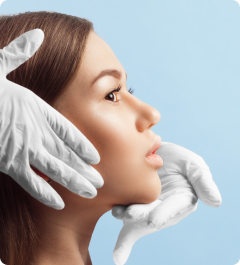Over the last several years, there has been increasing media attention regarding “Non Surgical Rhinoplasty “or the “Non Surgical Nose Job.” Essentially, this a relatively simple procedure in which a small amount of soft tissue filler – usually Hyaluronic acid – is injected into the “radix” of the nose above a nasal bump to give the illusion that the nasal bridge is straight and make the “bump” appear to disappear.
Good questions to ask about rhinoplasty are:
- Is this a safe procedure?
- Is the resultant cosmetic effect pleasant and long lasting?
- What subgroup of patients will benefit from the procedure?
The safety and risks of this procedure have been documented in several scientific medical journals. An excellent review was recently published by Dr. Theda C Kontis MD in the JAMA Facial Plastic Surgery-September 2017 Volume 19 number 5. As Dr. Kontis notes, Hyaluronic acid itself is a safe product with excellent biocompatibility and a very low adverse reaction ratio. Hyaluronic acid has been in use for approximately 2 decades and has been safely injected millions of times into the soft tissues of the face.
However, as Dr. Kontis notes, injecting the intricate anatomy of the nose with its thin skin and fibrous connective tissue and minute arteries and veins is very different than injecting the nasolabial folds or lips.
Complications of overinjection of the nose are well documented in the scientific literature and include skin loss, tissue death, “necrosis,” and, in worst-case scenarios – blindness.
It is very important that the injector has detailed knowledge of the intricate anatomy of the nose and eyes. They must especially be aware of the vascular plexus of the angular artery and vein. The blood vessels between the bridge of the nose and the corner of your eye.
The injector should also be able and trained to inject Hyaloronidase – the enzyme that dissolves Hyaluronic acid should a complication occur.
Personally, I, like most Facial Plastic Surgeons, have used Hyaluronic acid nasal injections for approximately 20 years in a small subgroup of patients that require micro injections 0.1-0.2 cc to correct small defects for asymmetries following surgical rhinoplasty. In this subgroup, the effects appear to be long lasting (1 to 2 years) and well tolerated.
I have also seen several patients who have undergone “Non Surgical Rhinoplasty” and were very unhappy with the results as it gave the bridge of the nose a very distorted shape from a direct frontal view-almost a Star Trek Klingon appearance. As well as distortion of the veins beside the eye. These patients were successfully treated with Hyaluronidase injections and subsequently underwent a “Surgical Rhinoplasty” with very good results.
Realistically, the vast majority of rhinoplasty procedures are reduction procedures. The patient feels his or her nose is too big. Injections above the bump simply make the nose bigger. Also, this technique does nothing to improve nasal function – a goal of many “Surgical Rhinoplasty” and has almost no application in treating nasal tip deformities or tip support issues.
Personally, I feel “ Non Surgical Rhinoplasty” is a simplistic solution to a complex problem.
I would urge all potential candidates to discuss the real risks of the procedure with their injectors.



